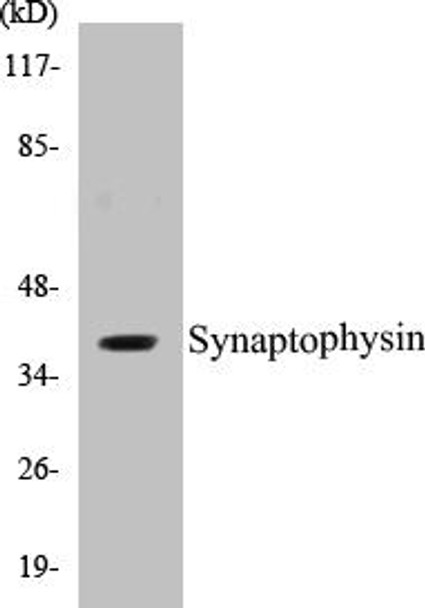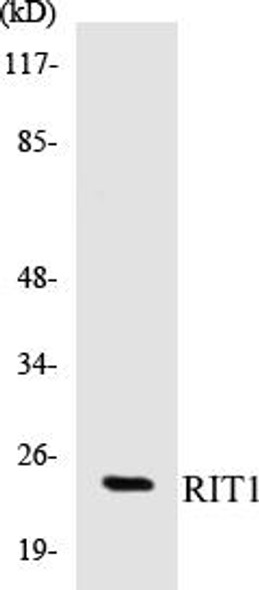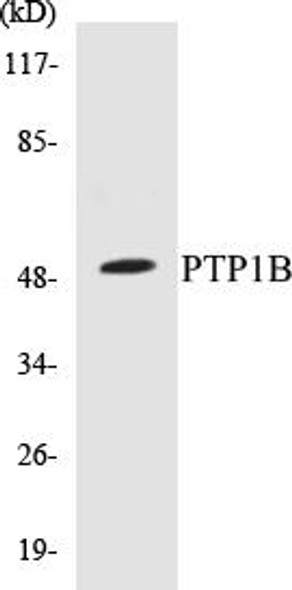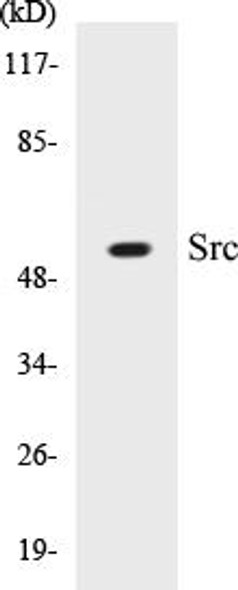Description
Synaptophysin Colorimetric Cell-Based ELISA Kit
The Synaptophysin Colorimetric Cell-Based ELISA Kit from AssayGenie is a powerful tool for the accurate detection of synaptophysin levels in cell samples. This kit offers high sensitivity and specificity, ensuring reliable and reproducible results for a variety of research applications.Synaptophysin is a key protein involved in synaptic vesicle trafficking and neurotransmitter release, making it essential for proper neuronal function. Dysregulation of synaptophysin has been implicated in neurological disorders such as Alzheimer's disease and Parkinson's disease, making it a valuable biomarker for studying these conditions and developing potential therapies.
The Synaptophysin Colorimetric Cell-Based ELISA Kit provides researchers with a convenient and efficient way to assess synaptophysin levels in cell samples, allowing for in-depth studies of synaptic function and dysfunction. Trust AssayGenie's ELISA kit for accurate and reliable results in your research endeavors.
| Product Name: | Synaptophysin Colorimetric Cell-Based ELISA Kit |
| Product Code: | CBCAB00199 |
| ELISA Type: | Cell-Based |
| Target: | Synaptophysin |
| Reactivity: | Human, Mouse, Rat |
| Dynamic Range: | > 5000 Cells |
| Detection Method: | Colorimetric 450 nmStorage/Stability:4°C/6 Months |
| Format: | 96-Well Microplate |
The Synaptophysin Colorimetric Cell-Based ELISA Kit is a convenient, lysate-free, high throughput and sensitive assay kit that can detect Synaptophysin protein expression profile in cells. The kit can be used for measuring the relative amounts of Synaptophysin in cultured cells as well as screening for the effects that various treatments, inhibitors (ie siRNA or chemicals), or activators have on Synaptophysin.
Qualitative determination of Synaptophysin concentration is achieved by an indirect ELISA format. In essence, Synaptophysin is captured by Synaptophysin-specific primary antibodies while the HRP-conjugated secondary antibodies bind the Fc region of the primary antibody. Through this binding, the HRP enzyme conjugated to the secondary antibody can catalyze a colorimetric reaction upon substrate addition. Due to the qualitative nature of the Cell-Based ELISA, multiple normalization methods are needed:
| 1. | A monoclonal antibody specific for human GAPDH is included to serve as an internal positive control in normalizing the target absorbance values. |
| 2. | Following the colorimetric measurement of HRP activity via substrate addition, the Crystal Violet whole-cell staining method may be used to determine cell density. After staining, the results can be analysed by normalizing the absorbance values to cell amounts, by which the plating difference can be adjusted. |
| Database Information: | Gene ID: 6855, UniProt ID: P08247, OMIM: 313475/300802, Unigene: Hs.632804 |
| Gene Symbol: | SYP |
| Sub Type: | None |
| UniProt Protein Function: | SYP: Possibly involved in structural functions as organizing other membrane components or in targeting the vesicles to the plasma membrane. Involved in the regulation of short-term and long-term synaptic plasticity. Homohexamer or homotetramer. Interacts with SRCIN1. Characteristic of a type of small (30-80 nm) neurosecretory vesicles, including presynaptic vesicles, but also vesicles of various neuroendocrine cells of both neuronal and epithelial phenotype. Belongs to the synaptophysin/synaptobrevin family. |
| UniProt Protein Details: | Protein type:Membrane protein, multi-pass; Vesicle; Membrane protein, integral Chromosomal Location of Human Ortholog: Xp11.23-p11.22 Cellular Component: cell junction; excitatory synapse; integral to synaptic vesicle membrane; neuron projection; presynaptic active zone; presynaptic membrane; synaptic vesicle; synaptic vesicle membrane; terminal button Molecular Function:cholesterol binding; identical protein binding; protein self-association; SH2 domain binding; transporter activity Biological Process: endocytosis; regulation of long-term neuronal synaptic plasticity; regulation of neuronal synaptic plasticity; regulation of short-term neuronal synaptic plasticity; synaptic vesicle maturation; synaptic vesicle membrane organization and biogenesis Disease: Mental Retardation, X-linked 96 |
| NCBI Summary: | This gene encodes an integral membrane protein of small synaptic vesicles in brain and endocrine cells. The protein also binds cholesterol and is thought to direct targeting of vesicle-associated membrane protein 2 (synaptobrevin) to intracellular compartments. Mutations in this gene are associated with X-linked mental retardation (XLMR). [provided by RefSeq, Aug 2011] |
| UniProt Code: | P08247 |
| NCBI GenInfo Identifier: | 135162 |
| NCBI Gene ID: | 6855 |
| NCBI Accession: | P08247.3 |
| UniProt Secondary Accession: | P08247,Q6P2F7, B2R7L6, B7Z359, |
| UniProt Related Accession: | P08247 |
| Molecular Weight: | 20,757 Da |
| NCBI Full Name: | Synaptophysin |
| NCBI Synonym Full Names: | synaptophysin |
| NCBI Official Symbol: | SYP |
| NCBI Official Synonym Symbols: | MRX96; MRXSYP |
| NCBI Protein Information: | synaptophysin |
| UniProt Protein Name: | Synaptophysin |
| UniProt Synonym Protein Names: | Major synaptic vesicle protein p38 |
| Protein Family: | Synaptophysin |
| UniProt Gene Name: | SYP |
| UniProt Entry Name: | SYPH_HUMAN |
| Component | Quantity |
| 96-Well Cell Culture Clear-Bottom Microplate | 2 plates |
| 10X TBS | 24 mL |
| Quenching Buffer | 24 mL |
| Blocking Buffer | 50 mL |
| 15X Wash Buffer | 50 mL |
| Primary Antibody Diluent | 12 mL |
| 100x Anti-Phospho Target Antibody | 60 µL |
| 100x Anti-Target Antibody | 60 µL |
| Anti-GAPDH Antibody | 60 µL |
| HRP-Conjugated Anti-Rabbit IgG Antibody | 12 mL |
| HRP-Conjugated Anti-Mouse IgG Antibody | 12 mL |
| SDS Solution | 12 mL |
| Stop Solution | 24 mL |
| Ready-to-Use Substrate | 12 mL |
| Crystal Violet Solution | 12 mL |
| Adhesive Plate Seals | 2 seals |
The following materials and/or equipment are NOT provided in this kit but are necessary to successfully conduct the experiment:
- Microplate reader able to measure absorbance at 450 nm and/or 595 nm for Crystal Violet Cell Staining (Optional)
- Micropipettes with capability of measuring volumes ranging from 1 µL to 1 ml
- 37% formaldehyde (Sigma Cat# F-8775) or formaldehyde from other sources
- Squirt bottle, manifold dispenser, multichannel pipette reservoir or automated microplate washer
- Graph paper or computer software capable of generating or displaying logarithmic functions
- Absorbent papers or vacuum aspirator
- Test tubes or microfuge tubes capable of storing ≥1 ml
- Poly-L-Lysine (Sigma Cat# P4832 for suspension cells)
- Orbital shaker (optional)
- Deionized or sterile water
*Note: Protocols are specific to each batch/lot. For the correct instructions please follow the protocol included in your kit.
| Step | Procedure |
| 1. | Seed 200 µL of 20,000 adherent cells in culture medium in each well of a 96-well plate. The plates included in the kit are sterile and treated for cell culture. For suspension cells and loosely attached cells, coat the plates with 100 µL of 10 µg/ml Poly-L-Lysine (not included) to each well of a 96-well plate for 30 minutes at 37°C prior to adding cells. |
| 2. | Incubate the cells for overnight at 37°C, 5% CO2. |
| 3. | Treat the cells as desired. |
| 4. | Remove the cell culture medium and rinse with 200 µL of 1x TBS, twice. |
| 5. | Fix the cells by incubating with 100 µL of Fixing Solution for 20 minutes at room temperature. The 4% formaldehyde is used for adherent cells and 8% formaldehyde is used for suspension cells and loosely attached cells. |
| 6. | Remove the Fixing Solution and wash the plate 3 times with 200 µL 1x Wash Buffer for five minutes each time with gentle shaking on the orbital shaker. The plate can be stored at 4°C for a week. |
| 7. | Add 100 µL of Quenching Buffer and incubate for 20 minutes at room temperature. |
| 8. | Wash the plate 3 times with 1x Wash Buffer for 5 minutes each time. |
| 9. | Add 200 µL of Blocking Buffer and incubate for 1 hour at room temperature. |
| 10. | Wash 3 times with 200 µL of 1x Wash Buffer for 5 minutes each time. |
| 11. | Add 50 µL of 1x primary antibodies (Anti-Synaptophysin Antibody and/or Anti-GAPDH Antibody) to the corresponding wells, cover with Parafilm and incubate for 16 hours (overnight) at 4°C. If the target expression is known to be high, incubate for 2 hours at room temperature. |
| 12. | Wash 3 times with 200 µL of 1x Wash Buffer for 5 minutes each time. |
| 13. | Add 50 µL of 1x secondary antibodies (HRP-Conjugated AntiRabbit IgG Antibody or HRP-Conjugated Anti-Mouse IgG Antibody) to corresponding wells and incubate for 1.5 hours at room temperature. |
| 14. | Wash 3 times with 200 µL of 1x Wash Buffer for 5 minutes each time. |
| 15. | Add 50 µL of Ready-to-Use Substrate to each well and incubate for 30 minutes at room temperature in the dark. |
| 16. | Add 50 µL of Stop Solution to each well and read OD at 450 nm immediately using the microplate reader. |
(Additional Crystal Violet staining may be performed if desired – details of this may be found in the kit technical manual.)






